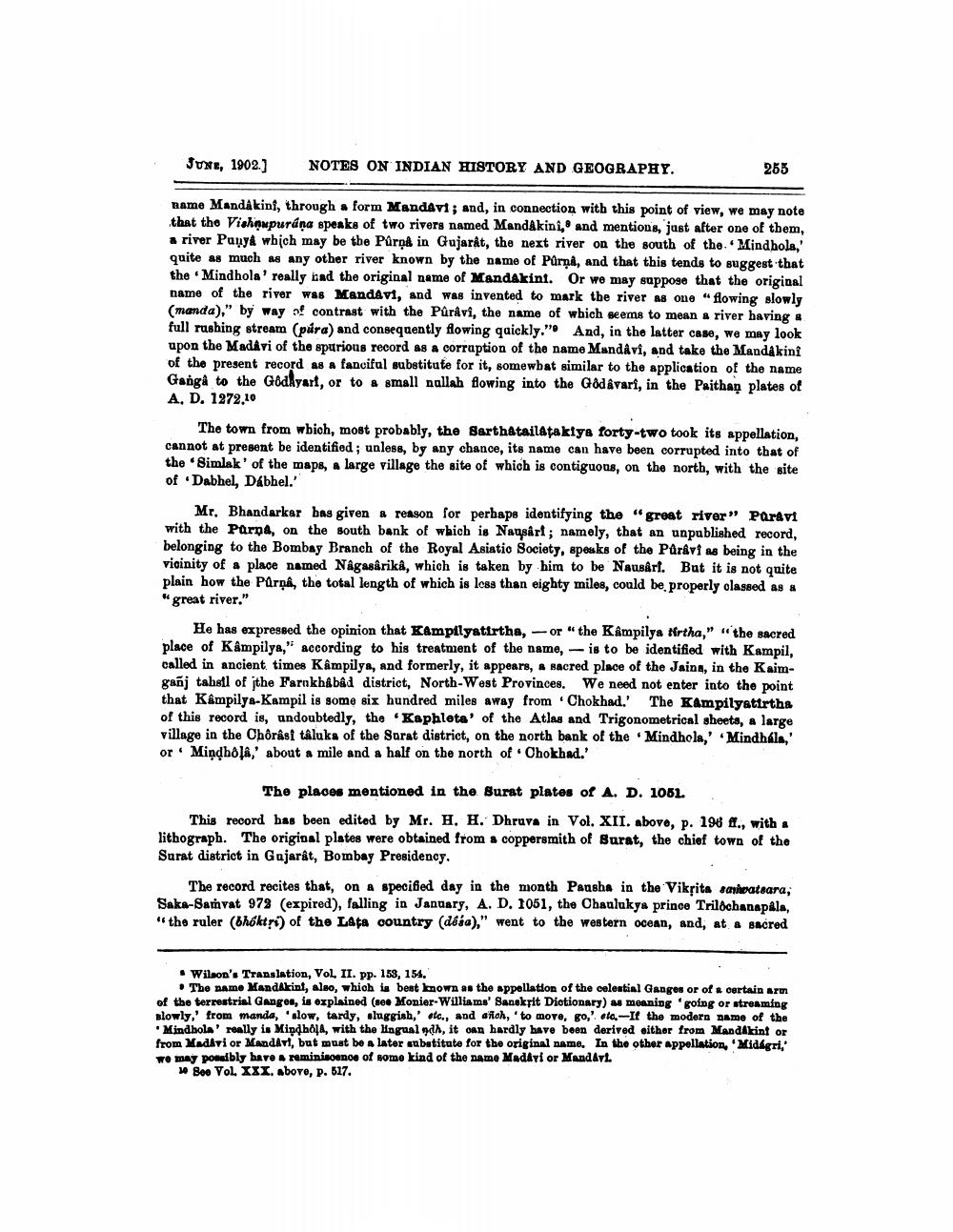________________
JUNE, 1902)
NOTES ON INDIAN HISTORY AND GEOGRAPHY.
255
name Mandakini, through a form Mandavi; and, in connection with this point of view, we may note that the Vishnupurdna speaks of two rivers named MandAkini, and mentious, just after one of them, a river Payya which may be the Purņd in Gujarât, the next river on the south of the Mindhola, quite as much as any other river known by the name of Purna, and that this tends to suggest that the Mindhola' really had the original name of Mandakint. Or we may suppose that the original name of the river was Mandavi, and was invented to mark the river as one "flowing slowly (manda)," by way of contrast with the Pûråvi, the name of which seems to mean a river having & full rashing stream (pára) and consequently flowing quickly."' And, in the latter case, we may look upon the Madhvi of the spurious record as a corraption of the name MandAvi, and take the Mandakini of the present record as a fanciful substitute for it, somewbat similar to the application of the name Gangå to the Godhyart, or to a small nallah flowing into the Godavari, in the Paithan plates of A, D. 1272.10
The town from which, most probably, the SarthAtailAtaklya forty-two took its appellation, cannot at present be identified ; unless, by any chance, its name can have been corrupted into that of the 'Simlak' of the maps, a large village the site of which is contiguous, on the north, with the site of Dabhel, Dábbel.'
Mr. Bhandarkar has given a reason for perbape identifying the “great river" Paravi with the Parna, on the south bank of which is Nagsart; namely, that an unpublished record, belonging to the Bombay Branch of the Royal Asiatic Society, speaks of the Pârâvi as being in the vicinity of a place named Nagasarika, which is taken by him to be Nausârt. But it is not quite plain how the Parna, the total length of which is less than eighty miles, could be properly classed as a "great river."
He has expressed the opinion that Kampilyatirtha, -- or "the Kâmpilya tirtha," "the sacred place of Kâmpilya," according to his treatment of the name, - is to be identified with Kampil, called in ancient times Kampilya, and formerly, it appears, A sacred place of the Jains, in the Ksimganj tahsil of the Farnkhabad district, North-West Provinces. We need not enter into the point that Kampilya-Kampil is some six hundred miles away from Chokhad.' The Kampilyatirths of this record is, undoubtedly, the Kaphleta' of the Atlas and Trigonometrionl sheets, a large village in the Christ taluks of the Surat district, on the north bank of the Mindhola,' Mindhála, or Mindhol,' about a mile and a half on the north of Obokhad.'
The places mentioned in the Burat plates of A. D. 1061
This record bas been edited by Mr. H. H. Dhruva in Vol. XII. above, p. 198 ff., with a lithograph. The original plates were obtained from a coppersmith of Surat, the chief town of the Sarat district in Gujarat, Bombay Presidency.
The record recites that, on a specifed day in the month Paasha in the Vikrita saatsara. Sake-Samvat 973 (expired), falling in January, A. D. 1051, the Chaulukys prince Trilochanapala, "the ruler (6h6ktry) of the Laţa country (désa)," went to the western ocean, and, at a sacred
• Wilson'. Translation, VOL. II. Pp. 153, 154.
• The name Mandakint, also, whiob is best known as the appellation of the celestial Ganges or of certain arm of the terrestrial Gange, is explained (noMonier-Williams' Sanskrit Dictionary) as moaning 'going or streaming slowly from manda, 'slow, tardy, sluggish,' etc., and afich, 'to move, go, lo. If the modern name of the
Mindhola' really is Mindhol, with the lngual odh, it can hardly have been derived either from MandAkint or from Madiri or Mandant, but must be a later substitute for the original name. In the other appellation, 'Midagri. We may posibly have a nminiscence of some kind of the name Madayi or Mandart
0 Bee YOL XXX. above, p. 617.




